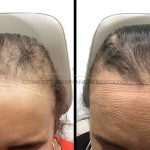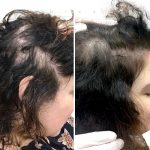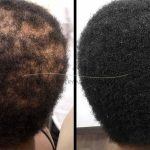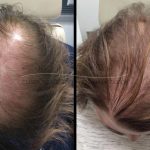Hair Loss
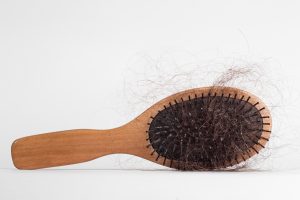 Scalp hair grows about half an inch per month and sheds about 100 hairs a day. Over 80 million men and women in America experience hair loss, whether the cause is genetic, medical, or environmental. If you’re noticing a significant increase with your hair shedding, it may be time to see a CCSD Dermatologist to determine if you’re experiencing hair loss and create a customized treatment plan.
Scalp hair grows about half an inch per month and sheds about 100 hairs a day. Over 80 million men and women in America experience hair loss, whether the cause is genetic, medical, or environmental. If you’re noticing a significant increase with your hair shedding, it may be time to see a CCSD Dermatologist to determine if you’re experiencing hair loss and create a customized treatment plan.
Most Common Types of Hair Loss
There are many types of hair loss, also called alopecia, but these are the most common that we see at Chicago Cosmetic Surgery and Dermatology.
Androgenetic Alopecia
The most common type of hair loss affecting more than 50 million men and 30 million women in the USA. It's usually referred as male pattern hair loss or female pattern hair loss, androgenetic alopecia is hereditary but can be managed.
Telogen Effluvium
Occurs when scalp hair follicles enter the resting phase of the hair growth cycle, called telogen, and start to shed simultaneously. This can be due to severe illness or crash diets, childbirth, severe emotional stressors, from stopping or starting birth control pills, low iron levels, low protein levels and many other reasons.
Cicatricial Alopecia
Most commonly seen in African American women, this condition affects the central top portion of the scalp, and gradually spreads leaving a large area of hair loss on the top and sides of the scalp.
Hair Loss Treatments
Our CCSD Providers will diagnose your type of hair loss and create a customized treatment plan from some of the following medications, products and treatments to help prevent future hair loss and regrow your hair.
Minoxidil
This topical and oral medication solution reverses hair thinning and stimulates new hair growth. It must be used every day for at least 6 months to determine if it is going to be helpful. We offer topical CCSD Hair Repair for Men and Women and Minoxidil 2.5mg tablets (prescribed by Rx only).
Vitamins
If you’re lacking essential vitamins necessary for hair growth, you may be prescribed biotin, selenium, zinc, magnesium, copper, and/or vitamin D among others.
Hair Growth Supplements
Our Dermatologists recommend to their patients Nutrafol or Viviscal Professional, which are marine protein-based supplements clinically proven to thicken and lengthen hair.
Finasteride (Men)
CCSD Rx Finasteride 1mg (Propecia) has been shown to primarily help hair growth at the vertex/crown of scalp, with some improvement at the temples in certain cases. It can also stop the hair loss process in most cases.
Spironolactone (Women)
CCSD Rx Spironolactone 50mg & 100mg has an effect on binding to normal androgen (hormones that damage or destroy hair follicles) in the bloodstream that may affect hair follicle density.
Revita Hair Stimulating Shampoo & Conditioner
Revita is a state-of-the-art hair-growth formula that works from the scalp outward, enhancing the volume and density of hair at the source and combats hair loss.
Platelet Rich Plasma (PRP)
PRP treatments use your own body’s blood plasma which contains essential proteins that stimulate natural hair growth. PRP therapy for hair loss is a treatment that involves withdrawing a patient’s own blood, spinning it so that only the enriched cells (platelet-rich plasma) remain, and injecting it into the scalp. The application of PRP causes hair follicles that are miniaturized to become larger and healthier, thus promoting hair growth. New hair growth can be seen as early as 2 months following treatment, but is usually more evident between 5-8 months. Hair growth will continue to improve up to a year after treatment.
How is the Platelet-Rich Plasma Procedure Perfomed?
 Blood is drawn in our office just like having a routine blood testing at a primary care physician’s office. The blood is spun in a centrifuge and the platelet rich plasma is separated from the red blood cells. CCSD uses the Eclipse PRP System, which is a quick, easy process that delivers consistent platelet concentration. Once the plasma is separated, it is then injected into the scalp where hair restoration is needed. PRP is close to a physiologic pH, which means it is less likely to cause a stinging or burning sensation. There may be some temporary discomfort or possible redness and inflammation at the application site, but quickly resolves. Equally important, PRP is produced from the patient’s own blood, there is virtually no risk of an allergic reaction or rejection. A course of treatments will be determined by the Provider during consultation.
Blood is drawn in our office just like having a routine blood testing at a primary care physician’s office. The blood is spun in a centrifuge and the platelet rich plasma is separated from the red blood cells. CCSD uses the Eclipse PRP System, which is a quick, easy process that delivers consistent platelet concentration. Once the plasma is separated, it is then injected into the scalp where hair restoration is needed. PRP is close to a physiologic pH, which means it is less likely to cause a stinging or burning sensation. There may be some temporary discomfort or possible redness and inflammation at the application site, but quickly resolves. Equally important, PRP is produced from the patient’s own blood, there is virtually no risk of an allergic reaction or rejection. A course of treatments will be determined by the Provider during consultation. Watch Dr. Fine and Dr. Ibrahim Discuss Hair Loss On The News




